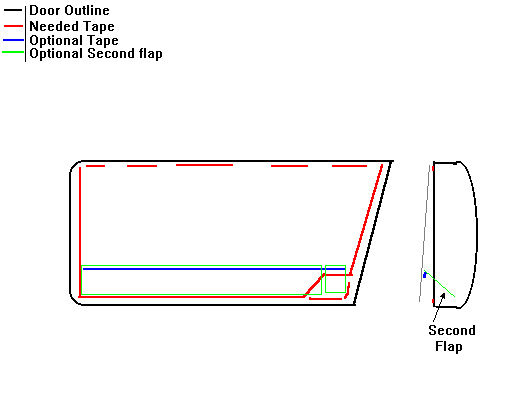
Problems:
To replace the interior seals, first remove the interior door trim. This should consist of the door handle (pry off at the bottom, then remove two screws), the bezzle near the arround the door latch (slide the plastic bezzle toward the rear of the car). Remove the window crank by removing the screw hidden under the plastic cover. There should be 4 screws holding the panel on as well as two or three clips on the top. The bottom is held is set in plastic hooks. Leave any switches until the panel can be moved slightly, then unplug them from behind the panel.
The hooks and screw anchors are snaped in and use a pin to secure them to the door. These pins may be forced out with a small allen wrench. There are some places where the metal behind the door will not allow the pin to come out the back. The easy solution to these is to force the clip out and replace it. New clips are about $2.50. If you lose the pins, check under the wax since I found a number of pins seem to have fallen in the door before the was was applied. A screw may be used in place of a pin but keep in mind that the pins also seal the hole.
The old plastic foil seal can be removed by pulling them off. Clean the old gule off with alchol or use a scraping tool. Be careful not to scratch the paint and if any paint is removed, repaint the scrached area to prevent rust. New seals can be obtained throught VW but they may not fit as expected. New seals cost from $12 to $18 each. A new seal can easily be made using any plastic film. I recomend using Warp's Flex-O-Glass and 3M's outdoor weather striping double sided tape. The VW seals come ready to put on with the gule attached. It should be above 40 degrees to use this tape. Make your own seal by cutting a peice of plastic to fit. The type does not matter much as long as it will last a long time. Recomendations include Flex-O-glass since its clear, carpet protecting runners since its thick and unlikely to degrade or thick drop cloth plastic as its much like what VW originaly used. The tape may not be strong enough to hold very thick plastic but will work fine for thiner films. The new seal drawing at the end as an example. Any holes that must be cut into the plastic should be shilded from water like the origianl holes. Also keep in mind that the seal might need to be pressed in by the interior panel so allow it to flex some.
After insalling new seals but before reinsalling the interior parts, check to see if there are any major leaks by taking the car to a car wash or using a garden hose. If there are any leaks, let the door dry out and reseal the problem area.
The lower gasket arround each window tends to shrink and dry out over time. These can be replaced easily by prying out the old one an pressing in a new one. VW currently sells a one size fits all gasket and they must be cut to fit. Do not use the old one as a size guage as it will be too short. Its best to leave it long and trim it down until it fits snugly. The new gaskets cost about $15 each.
| Back to Tim's Homepage | Back to current subject | Related Links | thogard@abnormal.com |
| This page was last updated Sunday, 09-Jul-1995 01:56:54 UTC | Copyright 2000-2020 | thogard™ is a trademark of Tim Hogard | |